Even in the stodgy, conservative realm of corporately-run superhero comics there is a good bit of social activism. From Wonder Woman, Black Panther and Luke Cage to Kamala Khan and Kate Kane, superhero comics have had powerful advocates for diverse groups and issues. One of the most noteworthy runs is O'Neil and Adams' series of "Green Lantern/Green Arrow" stories from the early 1970s.
At the time, they helped set the standard for socially-conscious superhero comics, but that was over 45 years ago. Here, we'll examine whether they're still relevant.
DREAM TEAM, ODD COUPLE
For much of the 1950s and 1960s, DC Comics was seen as a fairly risk-averse publisher, churning out inoffensive superhero stories far removed from the day's headlines. The growing influence of younger writers and artists started to change all that. Late in 1969, just before Denny O'Neil and Neal Adams famously returned Batman to his gothic urban avenger roots, each of them contributed separately to a Green Arrow makeover that was even more radical.
Adams struck first in August-September 1969' s"Brave and the Bold" #85, giving GA a spiffy new costume and a secret identity-threatening goatee. O'Neil followed in October 1969's "Justice League of America" #75, opening Oliver Queen's eyes to the plight of the working man by stripping the crimefighter of his fortune.
O'Neil and Adams then put it all together in April 1970's "Green Lantern" #76, as Ollie lectured Hal Jordan about how his pokey old Silver Age morality wasn't good enough for the new decade. With a question heard 'round the comics world, an anonymous African-American citizen then asked GL whether -- with his "blue skin" bosses and all his heroics on behalf of "orange skins" and "purple skins" -- he'd ever done anything for the "black skins." At that moment Hal represented the Establishment and Ollie the Revolution; and O'Neil and Adams wanted Hal with the Revolution.
Intentionally or not, Hal Jordan was ideal for O'Neil and Adams' consciousness-raising work, although it would have shifted fundamentally any Green Lantern's status quo. As a GL, Hal was subject to some very specific, rigid rules. His ring wouldn't work against anything colored yellow, it had to be recharged every 24 hours or it would run out of power, and he alone (for the most part) was charged with patrolling and safeguarding an entire space sector. His bosses in the Green Lantern Corps were the self-styled Guardians of the Universe, 36 omnipotent, omniscient immortals who lived on the planet Oa and had figured out how the universe as a whole needed to be run. (Since they weren't in the habit of telling anybody else what they'd figured out, they could well have been making it up as they went along.) Regardless, they deputized thousands of fearless, honest Green Lanterns, gave them ultra-powerful rings and batteries, and set them loose across the entire universe to keep the peace.
Since "GL" #76 came out about eleven years after Hal's introduction in September-October 1959's "Showcase" #22, readers hadn't been given much guidance on ... well, how much leeway each Lantern received in the discharge of their duties. The lone exception was Sinestro, the renegade Green Lantern, who decided to run his planet like a fascist paradise and got deposed by Hal as a result. (Sinestro was replaced by Katma Tui, who had to choose between a GL career and being a housewife.) Still, all this told us was that the Guardians weren't fascist overlords in disguise.
It didn't stop the Guardians from being overly paternalistic. The GL/GA stories marked the beginning of a "Hal Disobeys The Guardians" trope, revisited frequently over the next 14 years. From 1970 through 1994 Hal's actions earned him a punishment, exile, a voluntary quit -- and ultimately a psychotic break, in 1994's scorched-earth apocalypse "Emerald Twilight" which introduced Kyle Rayner.
YOU SAY YOU WANT A REVOLUTION
To counteract this paternalism -- in what now seems like the superhero equivalent of those movies where teenagers plead to a grim-faced city council that the grownups never listen -- O'Neil and Adams had Green Arrow dare a Guardian to come to Earth and accompany Ollie and Hal on their newly-hatched plan to find America. Naturally, the Guardian (Appa Ali Apsa, nicknamed the "Old-Timer") accepted, and spent the next five issues riding along with the heroes.
If the point is to change Hal's mind, why get a Guardian involved? For one thing, it preserved Hal's job as a Green Lantern by ensuring (via the Old-Timer's supervision) that he wasn't going too far out on a limb. More importantly, though, until "GL" #76 the Guardians basically didn't care whether a greedy Star City landlord could browbeat a woebegone tenant. As far as O'Neil and Adams were concerned, the Guardians represented the ultimate Establishment. They knew How Things Should Be and didn't have to justify themselves. In a very real sense, Green Arrow's beef wasn't with Green Lantern, but with his inflexible, out-of-touch bosses.
See, up until "GL" #76, the Guardians and the Corps were glorified elements of backstory. The point of "Green Lantern" was to have Hal fight supervillains on Earth or have sci-fi adventures on other planets. The Guardians facilitated his superheroics, and if necessary he could draw on backup from his fellow Green Lanterns. With the GL/GA stories, though, Hal figured out that he needed to do something different -- specifically, he needed to be socially conscious -- and that didn't necessarily mean fighting supervillains or having sci-fi adventures (although O'Neil and Adams had him do both).
O'Neil and Adams' 14 "Green Lantern/Green Arrow" stories were spread across 13 issues of "Green Lantern" and -- once "GL" had been cancelled with April-May 1972's issue #89 -- three issues of "The Flash." Besides the evil landlord of #76, they involved exploited laborers (#77), cults (#78), Native American land rights (#79), judicial abuses (#80), overpopulation (#81), consumerism (#84), drug addiction (#85-86), race relations (#87), activism in general (#87), and environmental concerns (#89).
OFF TO LOOK FOR AMERICA
Of course, we can examine the Green Lantern/Green Arrow stories through either of the main characters. Readers who sympathized with Green Arrow were probably thrilled to see him on the side of oppressed citizens and sticking up for progressive causes. However, readers who read "Green Lantern" for the adventures of Hal Jordan might have been frustrated by the extent to which their hero was dumped on, if not outright annoyed by the constant lectures from his new co-star.
Indeed, for a headliner Green Lantern sure gets beaten down a lot, especially in "GL" #76. While trying to break up a small-scale riot in the issue's first few pages, he earns the wrath of the rioters, who are upset at their landlord's decision to gentrify their apartment building. Green Arrow pops up at that point like a goateed, sardonic Jiminy Cricket, explaining the nuances of the situation to his JLA colleague. The scene is all about shifting GL's perspective from being automatically on the side of "law and order" -- a phrase GL uses to justify his intervention -- to looking deeper into the riot's root causes. Turns out the landlord has some criminal connections, so GL and GA work together to trick the landlord into confessing. Because this has gotten in the way of GL's more cosmic duties, a Guardian chastises him; but at that point Green Arrow issues his dare and the Guardian agrees to their cross-country journey.
As Hal goes from Establishment flunky to well-rounded human being, he gets fewer lectures. Part of this is because Hal's inner monologue takes over, reminding the reader that he's questioning himself and his literal role in the universe. Such is the case in issue #77, which allows Hal a bit of catharsis when his fists compensate for his weakened power ring. (The Guardians did that as a punishment.) Otherwise, although issue #77 features protesters and a guitar-strumming folksinger struggling against a ruthless businessman, beyond those trappings it's not as expressly relevant as some of the other GL/GA tales. For one thing, the businessman lives in a walled-off fortress and uses actual Nazis as his goon squad, which -- like the landlord's criminal ties in #76 -- seem intended to distinguish its villains from any litigious real-world counterparts.
Issue #78 features a similar distinction, as the hippie-ish cult leader Joshua is revealed to be a white supremacist who hypnotizes his followers and is itching for a race war against the local Native American tribe. The issue has already introduced a racist, sexist biker gang called the Demons, who only defeated Black Canary by running her down with a motorcycle. (Since this was shortly after Dinah got her Canary Cry, she was apparently a bit skittish about using it. In fact, it pops up rarely, if ever, in these stories.) There's also copious use of an offensive term for Native Americans -- a/k/a the nickname of Washington D.C.'s NFL team -- but that's an unfortunate artifact of the times.
Joshua nurses BC back to health, and GL and GA find her after their own run-in with the Demons; but GA's love can't break Joshua's spell. Instead, an armed Black Canary gets the drop on a dazed Green Arrow. Although GL finds himself in a position to stop her from shooting GA, he decides instead to see if she'll break Joshua's spell on her own; which she does. Green Arrow consoles her (in his way) by observing that everyone -- and by extension, society generally -- must overcome their own inner darkness.
The next issue (#79) picks up not long afterwards, as the tribe is faced with losing their property rights to some unscrupulous developers. While Green Lantern tries to find the paperwork which can save the land, Green Arrow disguises himself as legendary tribesman Ulysses Star, hoping to inspire the locals to fight back. Ultimately, GL can't stop an arsonist from destroying the records, but gets the local Congressman involved. This infuriates GA, who has no confidence that the government will do anything, and certainly not in the short term. The two heroes come to blows in a wordless fistfight narrated by quotes (from Norman Mailer's nonfiction novel "The Armies of the Night") about healing America. Although neither hero's solution prevails, the Old-Timer gives them points for trying. It may sound cheesy, and it risks reading cheesy, but undoubtedly it reflected O'Neil's convictions and probably resonated with many readers.
Issues #80 and #81 concern the Old-Timer's fate. In #80 he chooses saving GL's life over preventing an environmental disaster, and is called on the carpet by the Guardians. They order him to planet Gallo, an intergalactic tribunal where he'll be judged and (possibly) punished. However, Gallo's just been taken over by the insane maintenance man, who's imprisoned the judges and is using the planet's machines to run his own kangaroo court. This issue was a direct parody of activist Bobby Seale's criminal trial, where the judge had Seale shackled and gagged so he couldn't represent himself; and therefore Green Lantern, Green Arrow and the Old-Timer get the same treatment. Naturally, they break out of jail and set things straight; but the Old-Timer must still face the Guardians' justice.
That happens in #81, when despite the pleas of Green Lantern, Green Arrow and Black Canary the Old-Timer is stripped of his immortality and sentenced to live the rest of his life on the Guardians' homeworld of Maltus. Turns out, though, that Maltus has itself been taken over by Mother Juna, a fertility scientist whose practices have overpopulated the planet. ("Maltus," for those who might not have known, was a reference to 19th Century social scientist Thomas Robert Malthus.) Because it's a foregone conclusion that the heroes stop Mother Juna, O'Neil and Adams are more concerned with showing the horrific effects of overpopulation (via a two-page spread of violence, famine and disease); as well as the tragic motivation behind Mother Juna's experiments. She was always taught that being a mother was a woman's highest calling, and overcompensated because she couldn't have children of her own. Therefore, rather than coming across as a sadistic Granny Goodness type, O'Neil and Adams make her another victim of the patriarchy. Black Canary's horrified, apologetic sympathy says it all.
O'Neil and Adams take a break from social consciousness for issues #82 and #83, which are more straightforward adventure stories with touches of fantasy and horror. They also bring back Sinestro and Carol Ferris (both last seen in #74). In issue #82, Green Lantern, Green Arrow and Black Canary run afoul of the "Witch Queen," a/k/a Sinestro's sister (!), who traps GL in a nightmarish mythology-inspired dimension. Next, in issue #83, Black Canary goes to work at a sinister boarding school whose cruel headmaster -- aided by a gullible telekinetic child -- has already injured Carol. The latter issue has the more lasting impact, since it ends with GL revealing his secret identity to Carol and the two rekindling their romance.
Said romance plays a small role in issue #84, a fairly broad satire which features another classic GL villain, Black Hand. The cliché-spouting criminal is the silent partner in a scheme to take over the world via a meaningless trinket called the "kaloota" (named, clearly but randomly, for artist Michael W. Kaluta). Periodically it plays a wacky sound and sprays perfume, which distracts wearers from their problems and also makes them very suggestible. This produces a sequence eerily similar to today's "fake news" and "alternative facts," which elevates the modern resonance considerably.
Issues #85 and #86 are the classic "Speedy on heroin" issues which demonstrate how oblivious both Green Lantern and Green Arrow can be to the problems of early-1970s teenagers. Although GA is hip to the dangers of illegal drugs and can recognize when an addict is going through withdrawal -- matters he has to explain to GL -- he has little sympathy for them, and can't believe his own youthful ward would give in to their temptations. It's a big feet-of-clay moment for Ollie, who recognizes he's been so busy with his own life he's totally neglected Roy Harper's. Only when he's shot with one of his own arrows (by a crossbow-wielding mugger/addict) does he even think to check in with Speedy, who's been missing for weeks. For that matter, neither Hal nor Ollie nurses Roy back to health. That job falls to Black Canary, who O'Neil and Adams have portrayed as the most empathetic of the three Leaguers.
This brings O'Neil and Adams' messaging full circle. In issue #76, Green Arrow was invoking the deaths of Martin Luther King, Jr., and Robert F. Kennedy as part of his plea to the Guardian of the Universe; but in issue #85, it's Ollie who's out of touch with his own erstwhile sidekick. Moreover, instead of an emotionally-charged soliloquy about righteousness and truth, Roy delivers a low-key monologue lamenting the conditions which have brought him so low. The contrast undercuts Green Arrow's outspoken liberalism, but it also forces the reader to re-examine those positions. As Roy delivers his final speech to Ollie, Dinah and Hal, the focus is rightly on the teenager, although it ends on Ollie's proud tears. Ollie might not come across as more persuasive by the end of issue #86, but O'Neil and Adams have made him a stronger character.
If Green Arrow's ego took a beating in #85 and #86, Green Lantern took his first solo flight as an embryonic progressive in issue #87. The issue split up the pair, with Green Arrow starring in the Elliot S! Maggin-written "What Can One Man Do?" -- wherein a tragedy at a riot convinces Ollie to run for mayor -- and Green Lantern changing deputies in the landmark "Beware My Power." For the latter, O'Neil and Adams brought back another pre-existing supporting character, but this time it was a relatively obscure one; and Guy Gardner only enjoyed a couple of pages before being put back into limbo.
Again, the character dynamics of "Beware My Power" show how far Hal and the Guardians have come since issue #76. Once again, there's a conflict between the ivory-tower Guardians and the boots-on-the-ground Hal; but this time the immortals have found an outspoken man of the people to wield their power ring. John Stewart isn't an African-American Green Arrow, because his experiences are miles away from the ex-billionaire's. Instead, the architect has spent his life fighting against all manner of entrenched societal forces designed to keep him down. He doesn't take being Green Lantern that seriously because he understands that it won't solve all of his (or society's) problems overnight. It will, however, give him a chance to speak truth directly to power -- in this case, the racist presidential candidate he and Hal are charged with protecting.
While John's introduction certainly makes issue #87 the most "important" installment of O'Neil and Adams' tenure, it's also one of the most timeless. Hal and the Guardian might be having a theoretical debate about what qualities a potential Green Lantern needs, but John puts a face on their concerns. Green Lanterns are chosen for their honesty and fearlessness, and John expresses those qualities differently, but no less validly, than Hal does.
After the reprint-only issue #88, O'Neil and Adams wrapped up "Green Lantern's" initial run with the heavy-handed but effective issue #89. It ends with a bearded, long-haired ecoterrorist named Isaac crucified on the wing of a Ferris Aircraft jet, and Green Lantern and Green Arrow strung up similarly on either side of him. That tells you a lot about the tone of the story, but it's not the whole picture. Although Isaac might look like he stepped out of "Jesus Christ Superstar," his attitude (which includes sabotaging Ferris' machinery in life-threatening ways) is totally uncompromising. When Green Arrow tries to help Isaac escape from Green Lantern with a sleeping-gas arrow, Isaac labels him a polluter. Later, after GA suggests a compromise, Isaac fires back: "How can I compromise with death? Shall we have half-death -- shall we have half-disease -- shall we pollute half the population -- shall we have one child die instead of two?"
Because pollution has weakened Isaac's respiratory system, he dies on the makeshift cross; with Green Lantern and Green Arrow helpless to save him. (In yet another example of our heroes being frustratingly easy to subdue, the mob that strung them up has taken GL's power ring.) Eventually, they free themselves, just as Carol Ferris and one of her managers arrive. When a tone-deaf Carol notes blithely that "progress must always claim victims," this is too much for Green Lantern. His ring returned, the angry GL vaporizes one of the jets -- and stalks off with a grim-faced "send me a bill!"
WHAT DID TWO MEN DO?
O'Neil and Adams' final Green Lantern/Green Arrow story (from "Flash" issues #217-219, August-September 1972 to December 1972-January 1973) was more of an epilogue for Oliver Queen's journey. With his aim a little off thanks to his wound from issue #85, Green Arrow reaches his own breaking point when he kills a thug accidentally. He destroys his bow and arrows, shreds his costume and crashes the Arrowplane on his way to a remote monastery. Green Lantern and Black Canary spend most of the story looking for him, running afoul of Joshua's white-supremacist sister along the way. In the end, Ollie comes back to civilization because an injured Black Canary needs blood and they share the same rare blood type. Before GL can get Ollie to the hospital, though, Ollie must save his ring-slinging pal from a deathtrap. This gives Ollie his mojo back, just in time to start his own occasional backup series in February 1973's "Action Comics" #421.
That's as fitting a conclusion as any for the original Green Lantern/Green Arrow stories. As mentioned above, O'Neil and artist Mike Grell relaunched "Green Lantern" with August-September 1976's issue #90, reuniting Hal and Ollie (and occasionally Dinah) and picking up where the series had left off. This time, though, the stories weren't quite as topical, although the partnership lasted about three more years (until November 1979's issue #122).
In terms of continuity, the GL/GA stories had profound effects on both characters. Green Arrow's loud liberalism continued pretty much until Mike Grell's 1987 "Longbow Hunters" miniseries; and we've already mentioned Hal's "Defy The Guardians" trope. The latter led to two big changes in "Green Lantern": John Stewart succeeding Hal in 1984; and the Earth-based "Green Lantern Corps" team (which included Hal, John and Guy) which began in issue #201. When writer Gerard Jones and artist Pat Broderick relaunched "Green Lantern" in 1990, their initial storyline had the Old-Timer relocating to Oa all of the Earth cities he'd visited with Hal and Ollie -- an arc which later fueled John Stewart's "Green Lantern: Mosaic" series. In "GL" volume 3 issue #29 (Late September 1992), Jones and artist M.D. Bright even satirized the famous "orange and purple" skins moment.
Regardless, Geoff Johns and Ethan Van Sciver's "Green Lantern: Rebirth" miniseries revealed that Hal's negative tendencies were products of his possession by the evil Parallax entity, which first gained a foothold in Hal's psyche when he started to doubt himself. Therefore, in a very real sense the GL/GA stories may be seen not as Hal finding another dimension for his personality, but as the beginning of his long, slow decline into malaise and madness. Although we may not know what DC's post-"Rebirth" timeline will look like, the New 52 erased Hal and Ollie's shared history entirely -- arguing further that the GL/GA stories have become irrelevant to these characters.
On their own merits, though, the GL/GA stories are certainly evocative of the times they were intended to mirror. Adams' pencils -- inked variously by himself, Frank Giacoia, Dan Adkins, Dick Giordano and Berni Wrightson -- bring to vivid life the America of the early 1970s. As brilliant as "GL's" then-regular artist (and co-creator) Gil Kane was, it's hard to imagine these stories having quite the same impact if he had drawn them. Likewise, O'Neil's scripts must have seemed revelatory to readers of all stripes; because by and large they started talking about matters that DC superhero comics just didn't touch.
Today these stories must seem painfully earnest; but no matter the era, they represent the sprawling attempts of a singular creative team using superhero characters to make sense of a turbulent time. It wasn't just Green Arrow trying to get Green Lantern to question authority, it was Green Arrow having to confront his own preconceptions about his role in that power structure. Likewise, Green Lantern begins issue #76 by breaking up a riot and ends issue #89 so consumed with rage that he lashes out himself. O'Neil and Adams hammered home the fact that there were no easy answers -- even for a space-cop and an ace archer -- but neither did they want their characters or their readers to stop asking.
If for no other reason, that's enough to hold Denny O'Neil and Neal Adams' Green Lantern/Green Arrow stories in high regard. Sometimes they're too obvious, or even too maudlin. Sometimes the sentiment is laid on too thickly; and sometimes the earnestness feels too glib. There's also the inescapable fact that these are two white men trying to feel good about themselves. Today's superhero comics have plenty of characters from all walks of life, and that's fantastic. The Green Lantern/Green Arrow stories no longer have to feel responsible for inspiring entire generations all by themselves. Many of their subjects still resonate, though. In the end, these stories are worth reading, contemplating, and digesting, for their attempts to change both these characters and our world.

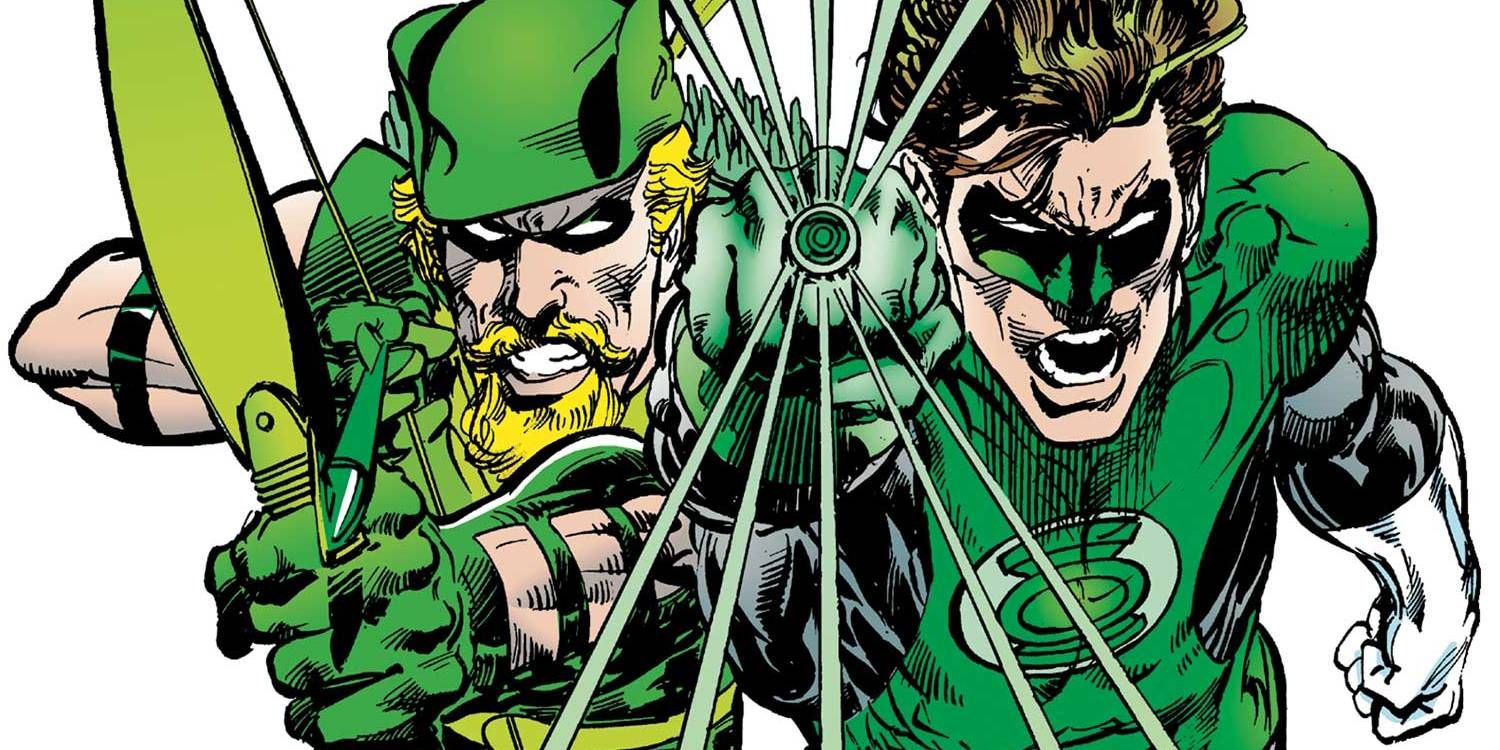
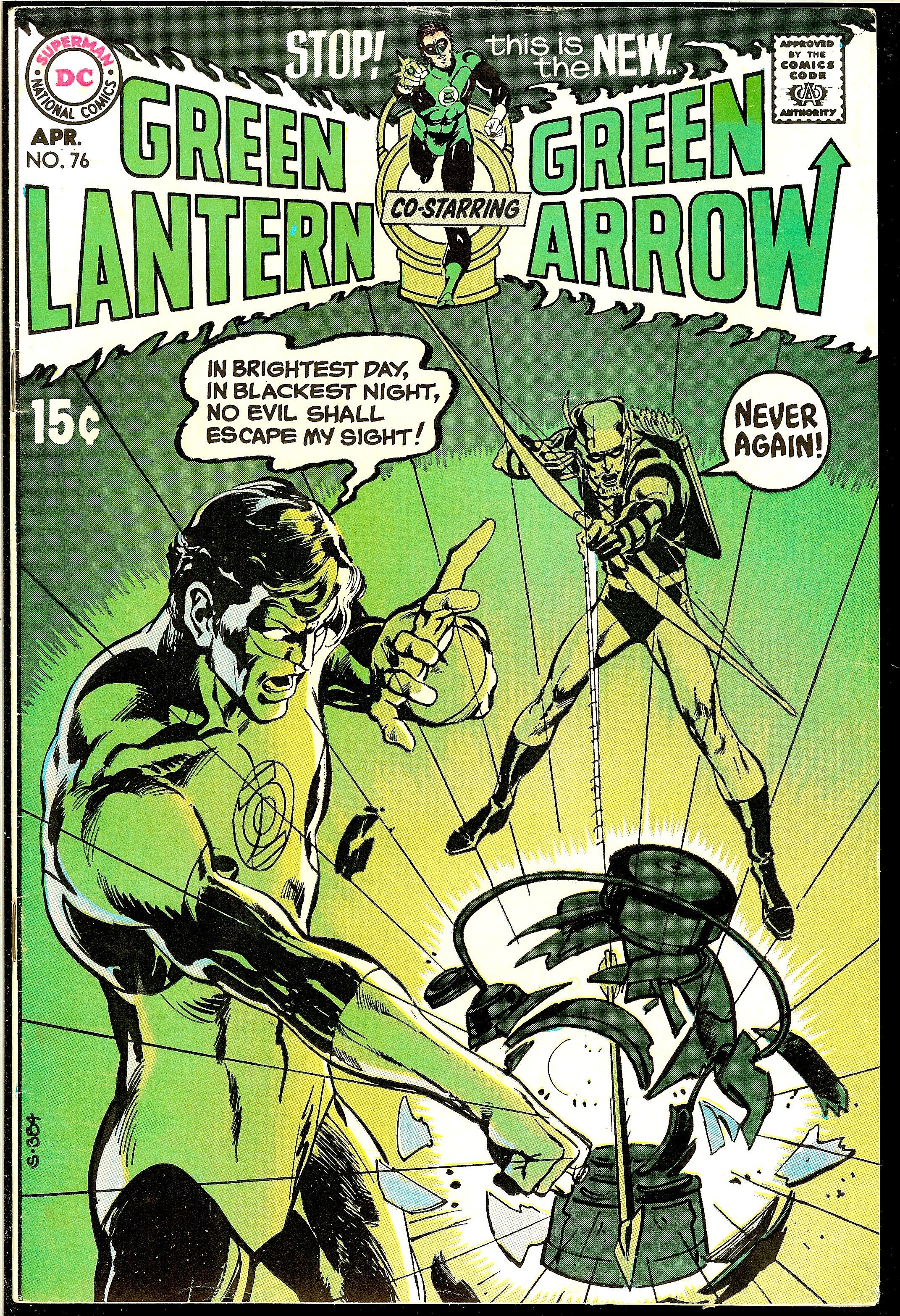
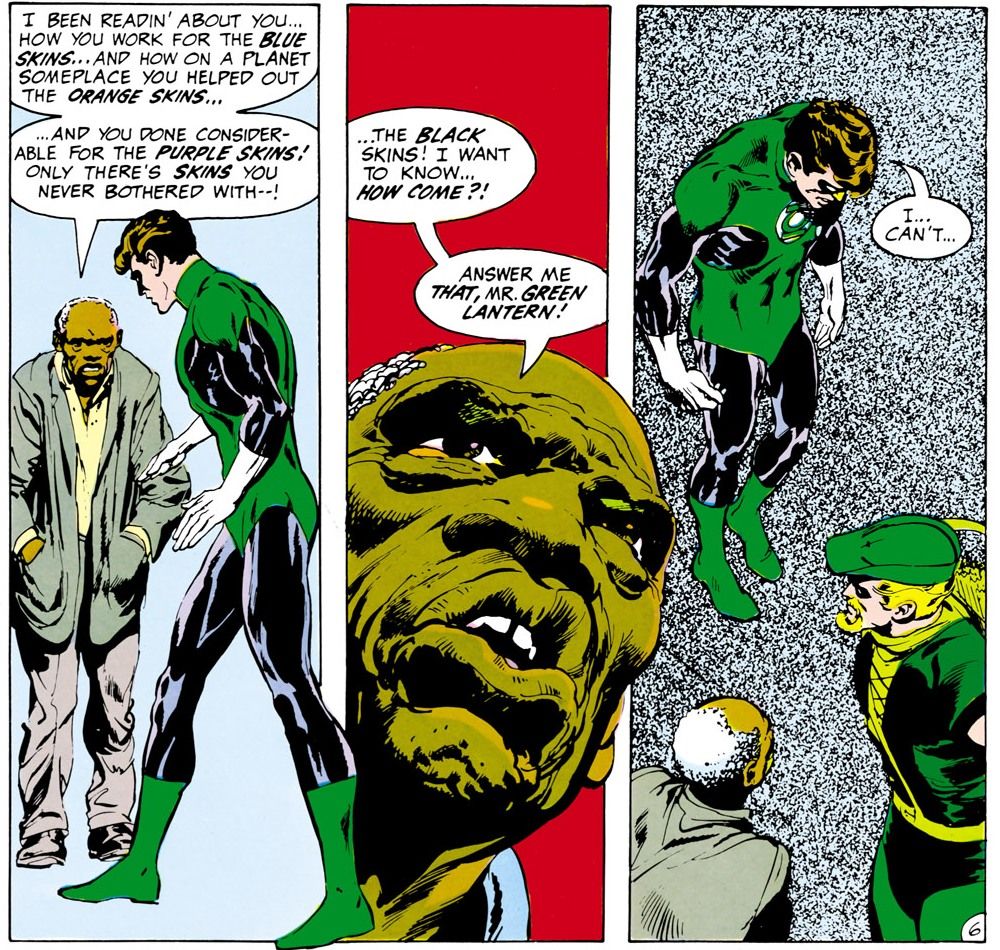
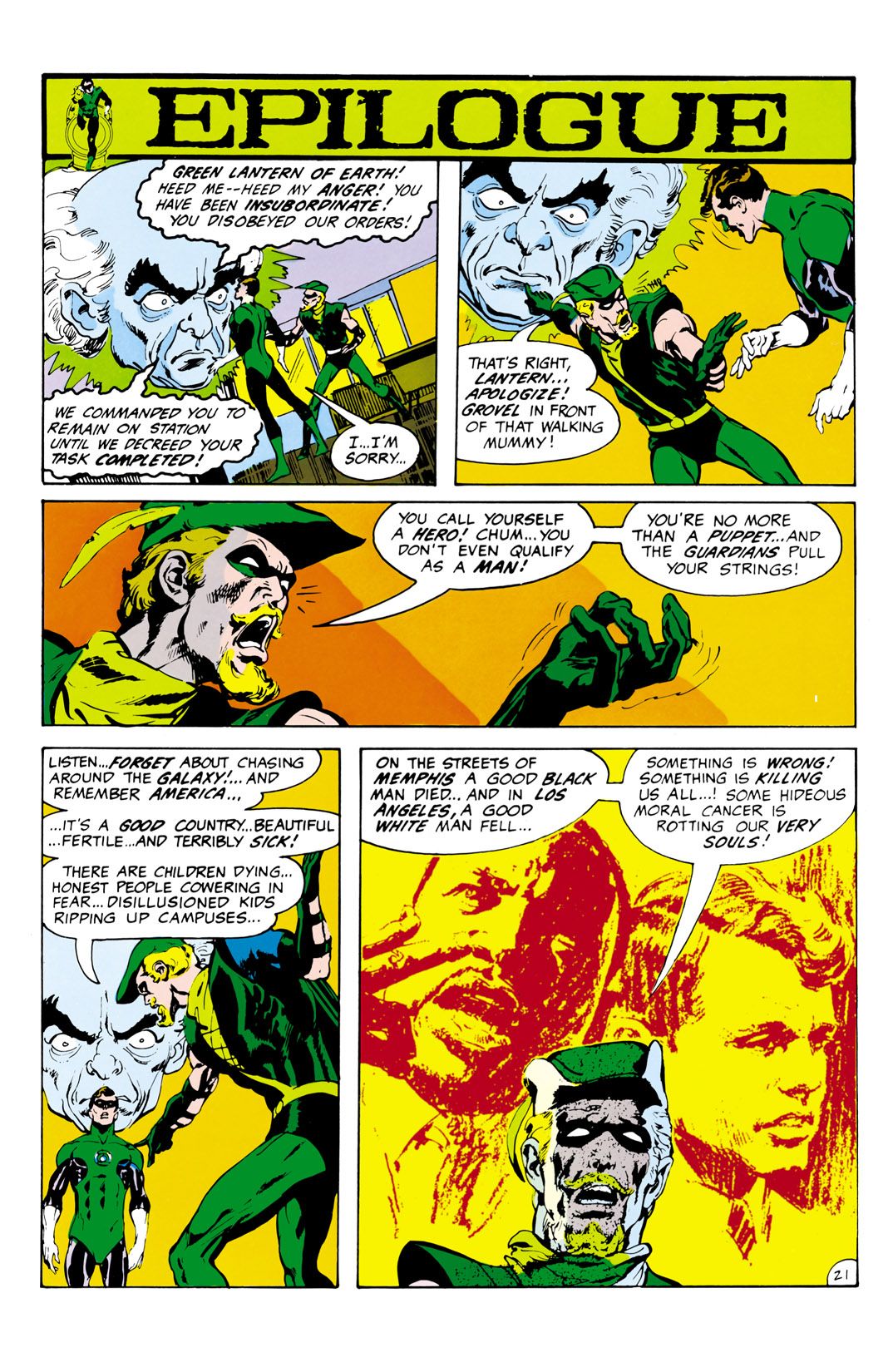
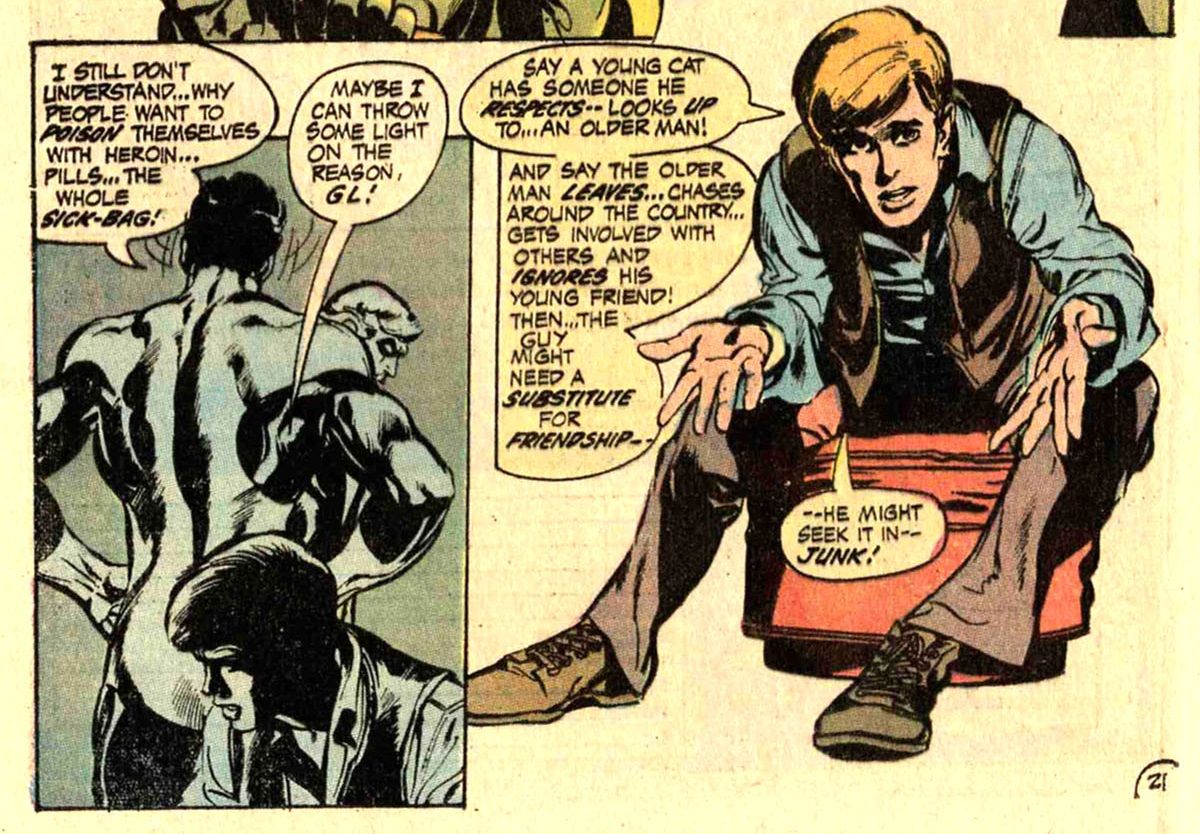
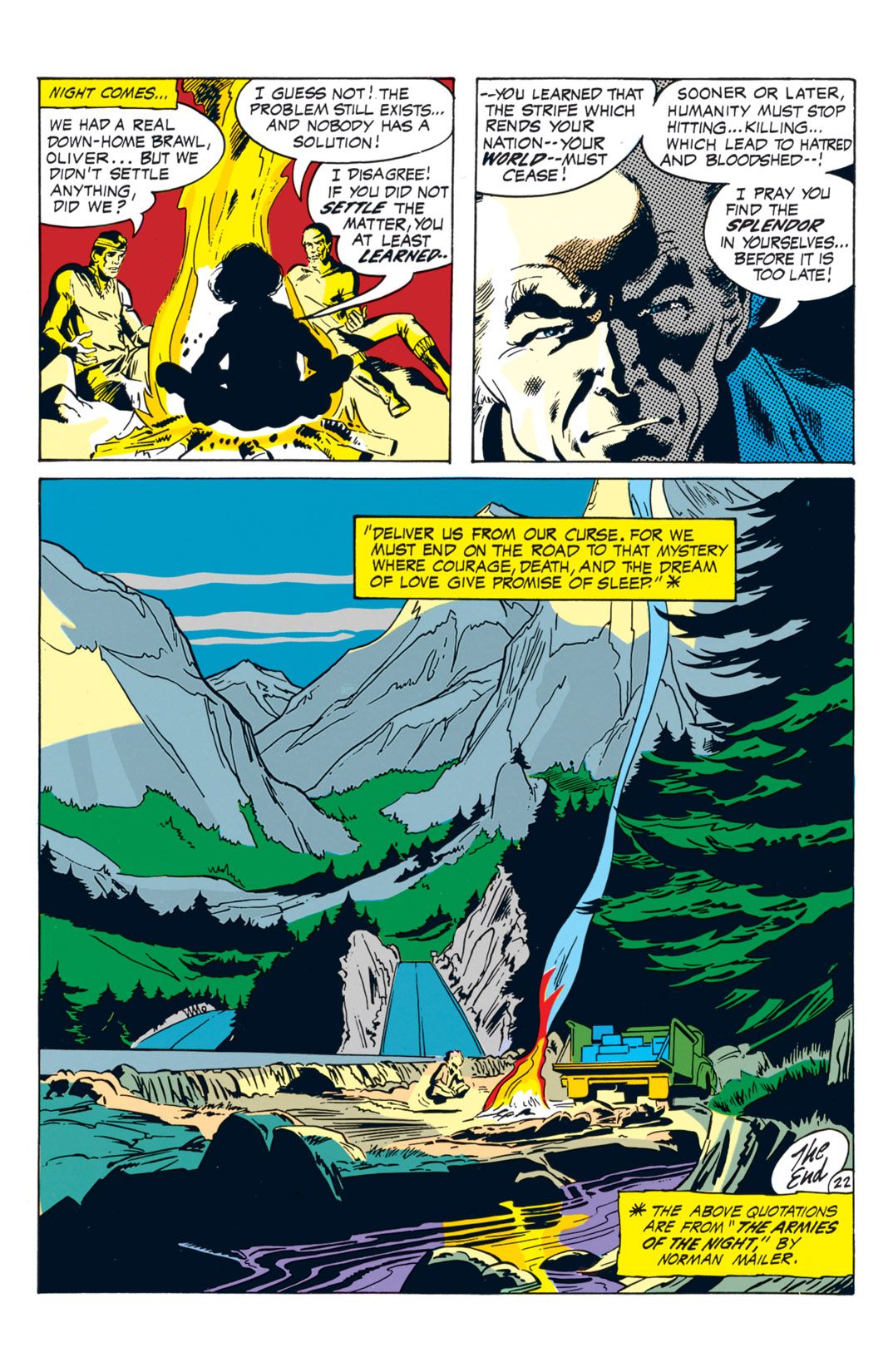
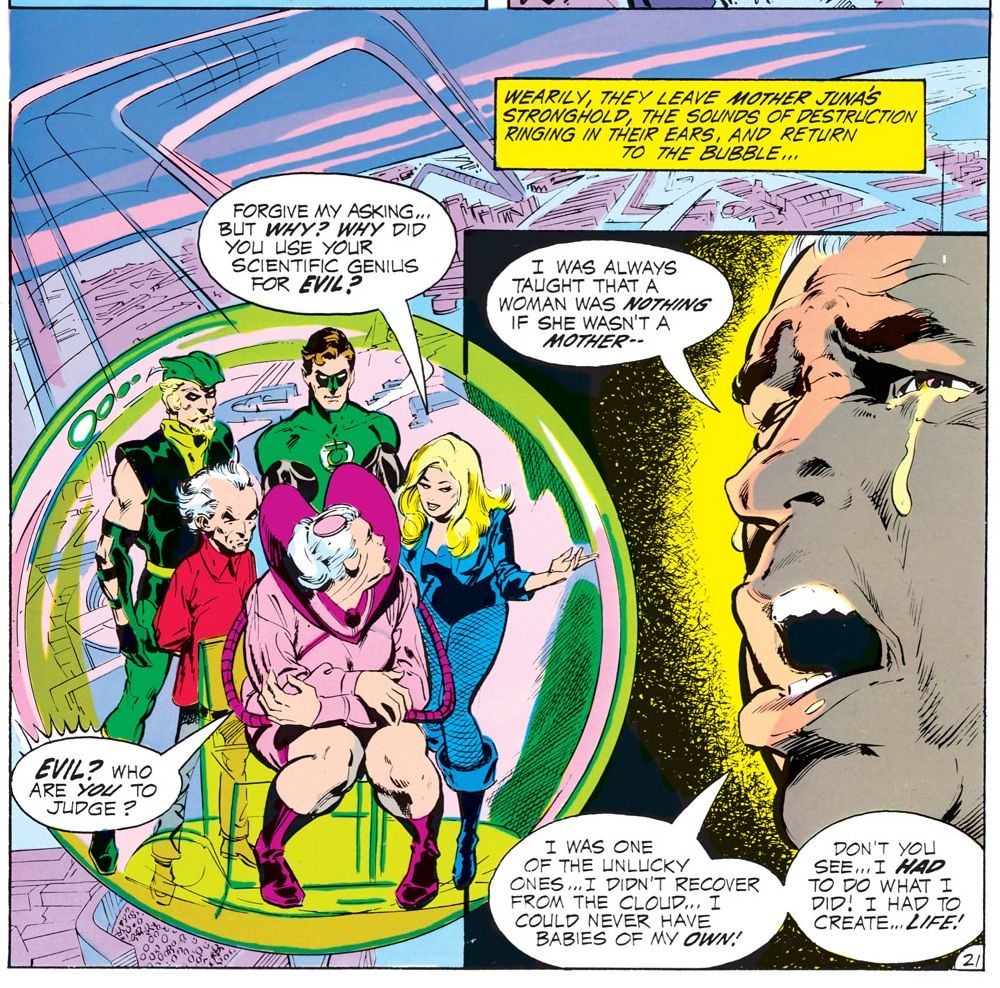
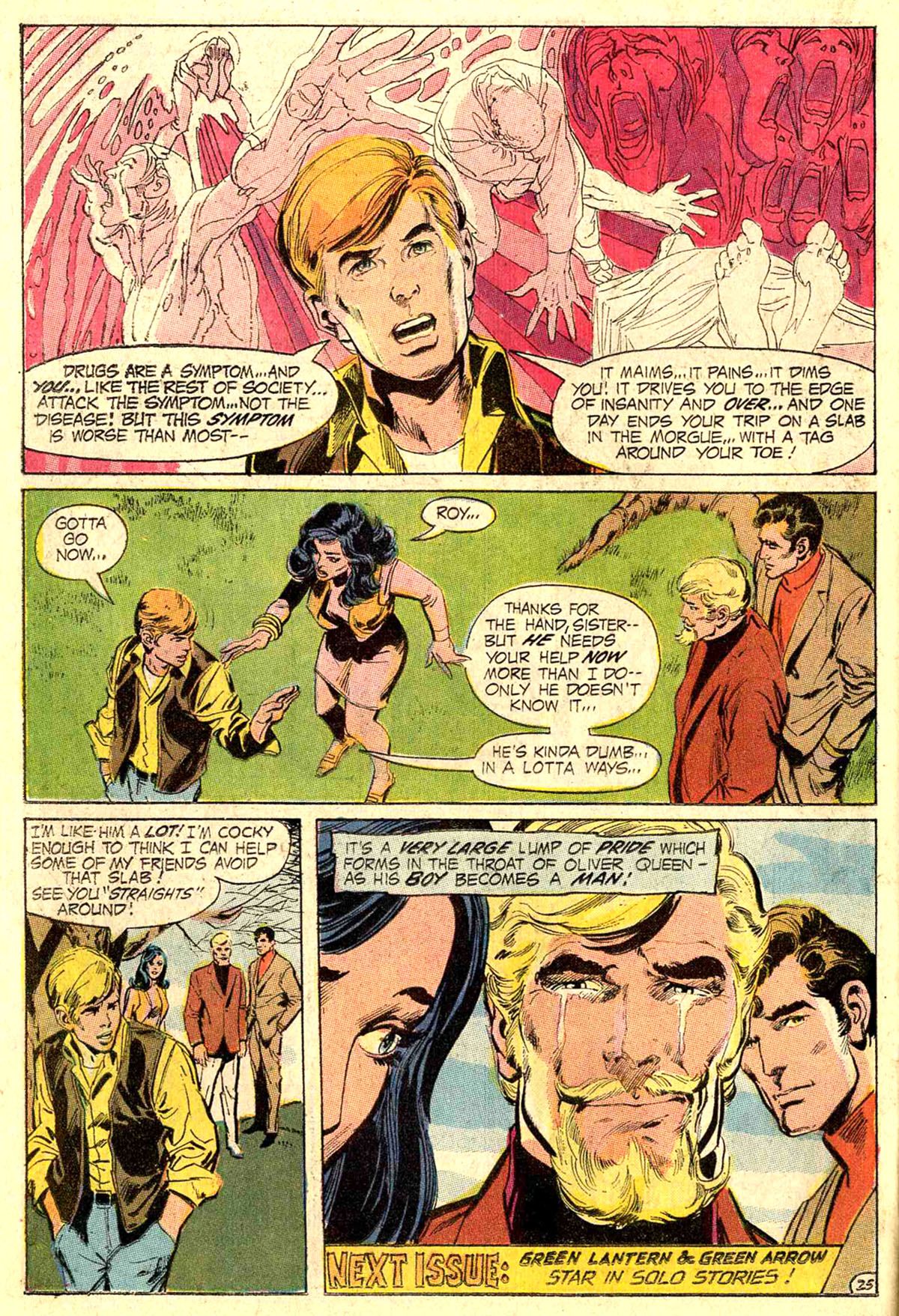
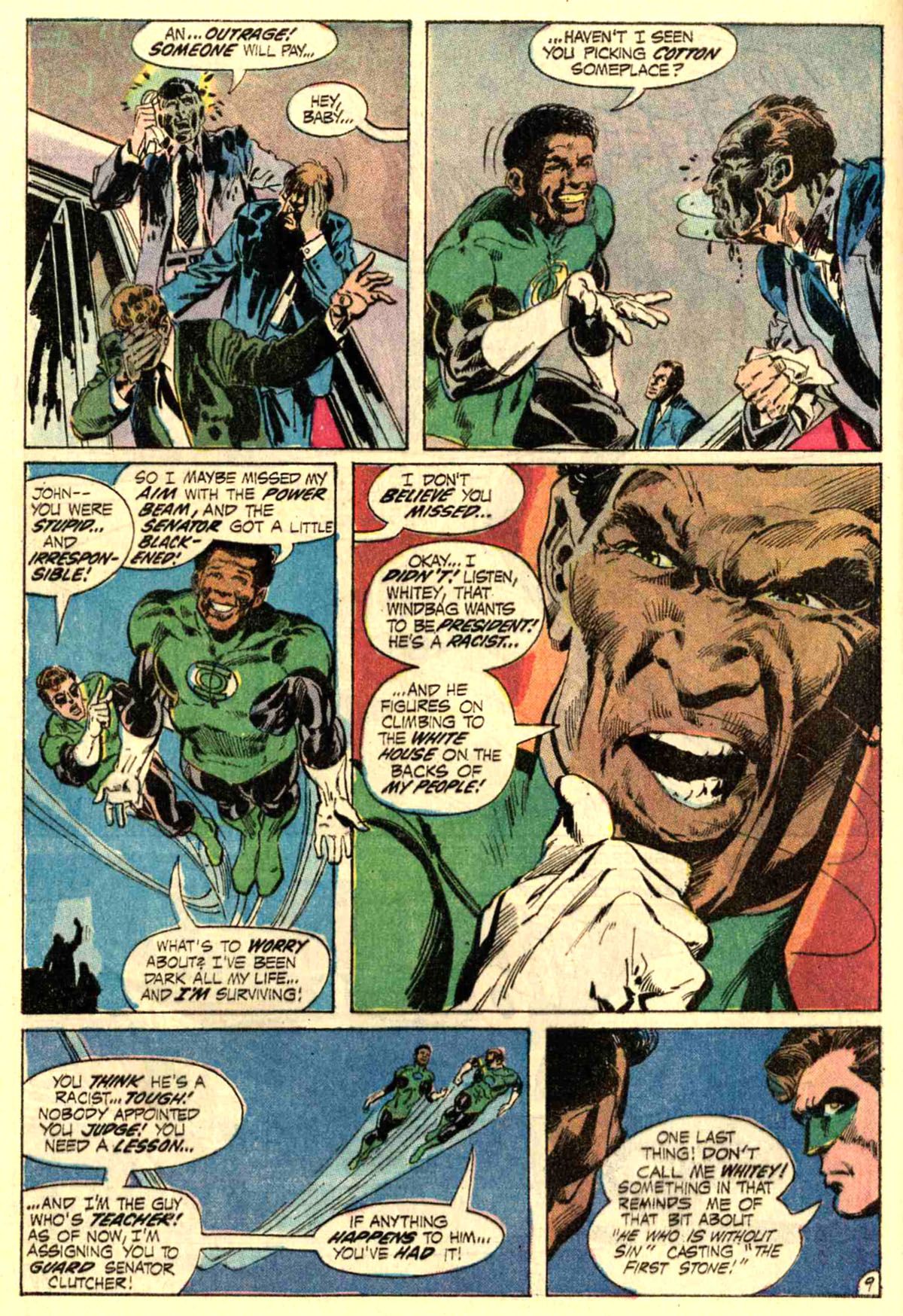
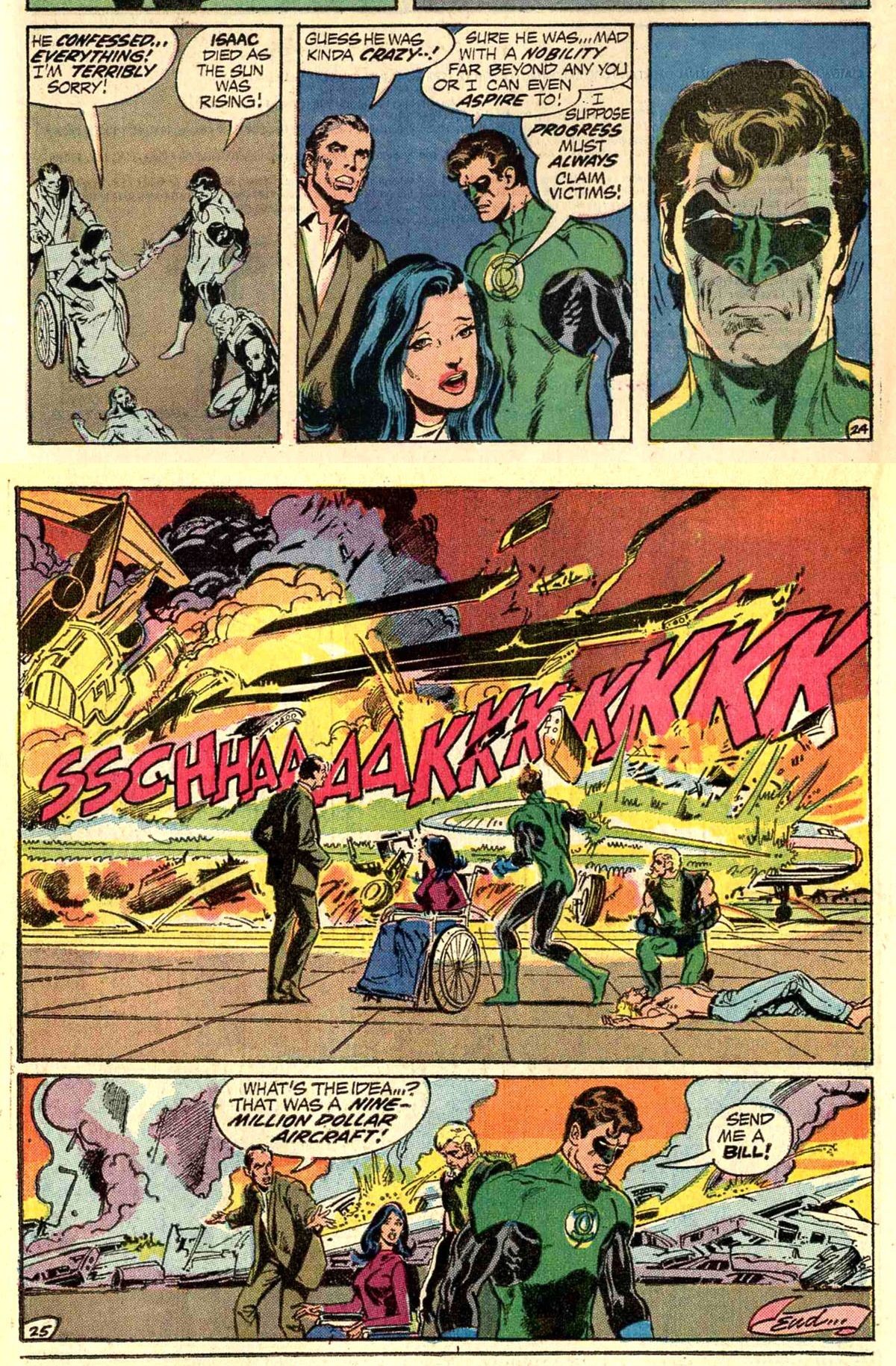
![[sad trombone]](https://static1.cbrimages.com/wordpress/wp-content/uploads/2017/03/green-lantern-vol-03-0029-page-19-abridged.jpg)